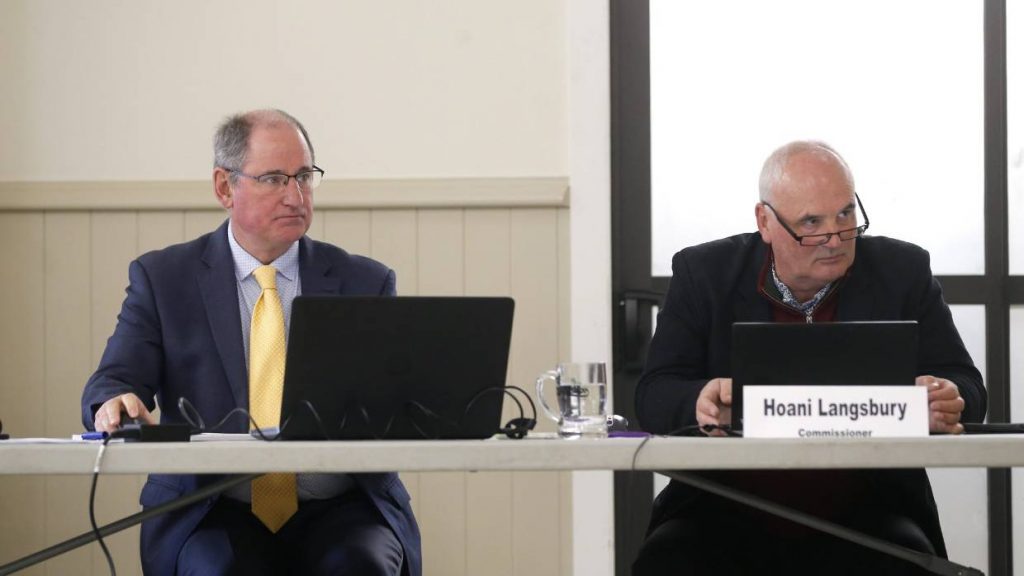“[Maori] swim in these waters, eat from these waters, any discharge has a direct impact on them as a person,” Kylie Hill, principal planner with Aoraki Environmental Consultancy Ltd, told a hearing into Oceania Dairy’s plan to build a 7.5 kilometre long wastewater pipeline into the ocean from its factory near Glenavy in South Canterbury.
She said Oceania Dairy had failed to carry out an iwi management plan which “suggests that the current application does not enable manawhenua to further exercise kaitiakitanga over their mana moana”.
Hill spoke alongside Upoko Tewera King and Ngāi Tahu legal counsel Rachel Robilliard as part of a collective submission from Te Runanga o Arowhenua, Te Runanga Waihao and Te Runanga o Ngāi Tahu who “remain fully opposed to the application”.
Commissioner Elizabeth Christmas highlighted that the applicant’s efforts to engage with iwi have been unsuccessful to which submitters replied the timeframe had not worked, particularly due to Covid-19 lockdown.
Panel chairman Paul Rogers said policy 23 in the New Zealand Coastal Policy Statement (NZCPA) specifically allows for this type of discharge, with conditions, while iwi management plans take a different stance.
When questioned, Hill conceded the NZCPA takes legal precedence.
Tewera King spoke to the cultural impact of the proposal upon Kāti Huirapa, whose history with the land goes back more than 70 generations.
“There has been a continuous relationship with the area surrounding the consent application for many many generations and it remains significant for Kāti Huirapa.”
King said part of his role is to “uphold Kāti Huirapa tikanga and kawa” and to ensure that mahinga kai may continue in traditional sites.
“That ability may be through promoting restoration and, in this case, is through preventing further degradation and restricted access to and within the coastal marine area,” he said.
“Washing pollution through the system does not remove its effects, and pumping waste out to sea does not remove or reduce the issue for mana whenua … it just moves the issue from one are to another, with different impacts for us to manage as kaitiaki.”
King said that while 20 years ago he would have thought the pipeline a great innovation, we know more about our impact now and know that “more needs to be done”.
When pressed by the panel, he was unable to clarify exactly where fishing takes place, except to say that it is largely groups that grew up together and have a relationship with landowners along the coast.
He also said that the list of significant sites provided to the panel in the original submission was constantly growing as more knowledge emerges and cultural mapping continues.
“Ours is not just a story of lost land but of lost stories.
“Our purpose here today is to try and keep as much of that cultural and physical landscape as possible.”
The panel asked King whether he thought cultural conditions to the consent would go someway to alleviate his concerns but King felt cultural monitoring would not be appropriate in this situation because of the “connectedness of everything” and the wider impact the discharge may have.
Robilliard presented a 20 page document, supplementary to original submissions, which identified policies and precedents in support of Ngāi Tahu’s submission.
Primary concerns included inadequate exploration of alternatives and inadequate assessment of the effects and cumulative effects of the discharge, from both a direct impact and holistic perspective.
Christmas questioned concerns about cumulative effects, asking “if water quality is being monitored [through consent conditions] then presumably cumulative effects are being managed because other than the discharge nothing else is happening?”
The same question was asked at intervals by other panel members but Ngāi Tahu maintained it was a valid concern stemming from a lack of data on the environment, ecological systems and setting of trigger levels.
Robilliard said because an adaptive management plan to monitor and mitigate accumulative issues was not a suitable model in this application a precautionary approach should be taken.
“Ngāi Tahu submit that a genuine precautionary approach is required in this case, in light of the proposed permanent modification of the sea floor through installing the outfall structure, and the presence of potentially vulnerable species and ecosystems in this area.
“In this respect, until sufficient information about the effects, and particularly the cumulative effects, of the application is better understood, Ngāi Tahu submit that the application should be avoided.”
Despite calling for the application to be declined, Ngāi Tahu made several condition recommendations should the application be granted.
These include that water will only be discharged to the ocean when it is not practicable to discharge to land; water should be treated to a higher standard before discharge; the maximum discharge volume is significantly less than the proposed volume; and the duration of the consents should be no more than 10 years.
Numbers and processes were not specified, and Christmas pointed out the proposed treatment is considered to be of a higher quality than the industry standard.













